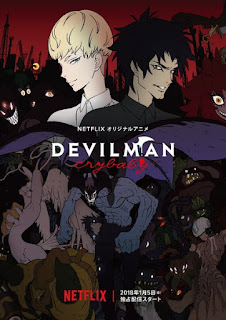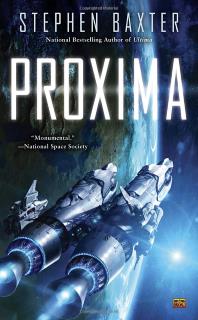Devilman Crybaby - masterpiece or masturbation?
 I've watched several lackluster recent Japanese animes from Netflix and I was feeling bored and disappointed with the clichés spouted by almost every character, most of them as cardboard as they can be. So when I started with Devilman Crybaby, a very original show both from the standpoint of the manga it adapts and the animation style, I was hoping for not being bored. And I wasn't. The show is fast, jumping from scene to scene and asking the viewer to extrapolate what happened in between. The characters are complex and seldom critical of one aspect or another of society, or representing such negative treats. Violence and sex are everywhere, although they are often depicted as kinds of vices and impulses that people have to fight against. The animation style is weirdly psychedelic. So did I like it? Not really.
I've watched several lackluster recent Japanese animes from Netflix and I was feeling bored and disappointed with the clichés spouted by almost every character, most of them as cardboard as they can be. So when I started with Devilman Crybaby, a very original show both from the standpoint of the manga it adapts and the animation style, I was hoping for not being bored. And I wasn't. The show is fast, jumping from scene to scene and asking the viewer to extrapolate what happened in between. The characters are complex and seldom critical of one aspect or another of society, or representing such negative treats. Violence and sex are everywhere, although they are often depicted as kinds of vices and impulses that people have to fight against. The animation style is weirdly psychedelic. So did I like it? Not really.Even from the beginning I was off put by the animation style. It's paradoxically both artistic and very simple. It made me think of Aeon Flux (the MTV animated series), which had several other things in common with this, as well. But I didn't let it bother me and I continued watching. As I said before, the characters are complex and the story is meandering around the peculiarities of each of them, which made it interesting. However, the plot was full of holes! Things that were "revealed" later on were evident from the beginning, people acted in weird ways that were eroding the suspension of disbelief. There were fights, but simplistic in nature and more inline with the symbolism that the author was so hard on. There were substories, but kept to a bare minimum. Do you see a pattern already?
Yes, in its entirety, things that were not important to the philosophical message that the anime wanted to make were abstracted, simplified or removed altogether. It is hard to enjoy any of it after you've got the memo. Even worse, perhaps because of its heavy (handed) symbolism, all the articles and reviews online praise it as a masterpiece. I said it before and I will say it again: just because it is not the usual crap it doesn't mean it's good. There are so many sorts of crap. You read two or three of them, discussing "what they meant", and you realize they are as full of shit as the makers of the anime. If you need to explain what you meant, the joke wasn't very good!
To be less of a dick about it, the show has many redeeming qualities, that is why I can't discuss too much the particulars without spoiling it, and you might want to watch it. However, to me, those qualities were wasted in the pseudo spiritual and moral bullshit that suffused the show. One alleviating circumstance is the source material, written in the 70s, which I have not read, so I can't really compare, but it was the 70s. Weird and wonderful stuff came from back then. This is mostly just weird. And I really hated the title.
Here is the trailer:

 What do you do if you want to make an anime that would be successful not only in Japan, but everywhere Netflix is watched? You take a bit of every successful anime and mix it all together. This is how you get the kingdom of Cremona, set somewhere in a nondescript time that has 1960's cars and cellphones and a nondescript place that looks like Europe, where experiments with the bones of god like creatures leads to superpowerful beings that are super crazy fast and shout Nipponisms with every opportunity: win and lose (in life, but seen as a game), protecting (someone, something, anything) just so your life makes some sense, "I will kill you with my own hands" and so on and so on, but also super smart detectives that figure things out, all for the sake of energetic, smart, cute and ultimately pointless much younger girls. But wait, there is more: there are crazy psychopaths that kill people and are super smart. There are arrogant evil people that have a lot of power, but are ultimately crazy, and which act as if everything and everybody is beneath them. And of course, all the fighting is done with magical swords and henchmen die quicker and with less talk than bosses, who are not particularly strong, but they just yap and yap and yap.
What do you do if you want to make an anime that would be successful not only in Japan, but everywhere Netflix is watched? You take a bit of every successful anime and mix it all together. This is how you get the kingdom of Cremona, set somewhere in a nondescript time that has 1960's cars and cellphones and a nondescript place that looks like Europe, where experiments with the bones of god like creatures leads to superpowerful beings that are super crazy fast and shout Nipponisms with every opportunity: win and lose (in life, but seen as a game), protecting (someone, something, anything) just so your life makes some sense, "I will kill you with my own hands" and so on and so on, but also super smart detectives that figure things out, all for the sake of energetic, smart, cute and ultimately pointless much younger girls. But wait, there is more: there are crazy psychopaths that kill people and are super smart. There are arrogant evil people that have a lot of power, but are ultimately crazy, and which act as if everything and everybody is beneath them. And of course, all the fighting is done with magical swords and henchmen die quicker and with less talk than bosses, who are not particularly strong, but they just yap and yap and yap. I found
I found  Literally translating to "The town where only I am missing", Boku dake ga Inai Machi presents (what else?) a manga artist with no life or future who finds out he can transfer his consciousness in the past, fixing things that went wrong. Of course, the worse thing that ever happened to him was living through a killer's series of murders of some of his school classmates. Another traumatic experience makes him, now 29 years old, transfer his consciousness in the past, during his childhood years, and determined to find and stop the killer.
Literally translating to "The town where only I am missing", Boku dake ga Inai Machi presents (what else?) a manga artist with no life or future who finds out he can transfer his consciousness in the past, fixing things that went wrong. Of course, the worse thing that ever happened to him was living through a killer's series of murders of some of his school classmates. Another traumatic experience makes him, now 29 years old, transfer his consciousness in the past, during his childhood years, and determined to find and stop the killer. 
